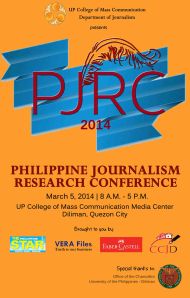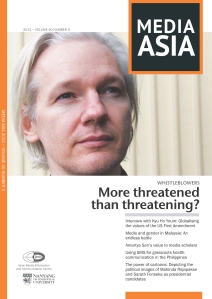Source: Why Wonder Woman matters
PJRC 2016

The Journalism Department of the University of the Philippines Diliman is organizing the 2016 Philippine Journalism Research Conference (PJRC) this April 12 (Tuesday).The Department is now accepting entries / papers / abstracts from undergraduate students for the following categories:
- Academic research – Thesis or full research papers on journalism and media studies;
- Investigative report – Investigative reports written or produced for print, broadcast or online media;
- Special project – Lengthy, in-depth feature or analysis in text, audio, photo, video or multimedia.
Abstracts / Entries / Papers may be emailed to jalinmanalo@gmail.com on or before March 11, 2016. The Notice of Acceptance for qualified entries will be issued a week after.
For questions surrounding the categories, you may call the UP Department of Journalism at (+632) 920.6852. Its department chair is Prof. Evelyn Katigbak (up.katigbakevelyn@gmail.com).
students’ work
Travel map
ricci has been to: Australia, Austria, Canada, Denmark, France, Germany, Hong Kong, India, Indonesia, Italy, Japan, Macao, Malaysia, Myanmar, Netherlands, New Zealand, Philippines, Singapore, South Korea, Spain, Switzerland, Thailand, United Kingdom, United States, Vatican, Vietnam. Get your own travel map from Matador Network.
J103 Student Public Opinion Video Projects
Proud of my J103 Student Public Opinion Video Projects..
1. On the Academic Calendar Shift:
2. On the Million People March
3. On the BIR Shame Campaign
4. On the QC Relocation on Agham Rd.
Journalism Student Conference
Journalism research conference draws 300 student researchers
Some 300 hundred student-researchers in journalism and their teachers are expected to attend the second Philippine Journalism Research Conference on Wednesday, March 5. The activity, organized by the Department of Journalism of the UP College of Mass Communication at UP Diliman, will be held at the UP-CMC Media Center.
The attendance is significant not only because it is bigger than last year’s research conference but also because it shows a growing interest in journalism research as an approach to improving the practice of journalism. Research, as American journalism guru Jay Rosen (2004), said ” maps and draws borders around the practice (of journalism) and define what’s within or beyond.”
The highlight of the conference is the panel judging of 12 researches selected from 50 abstract submitted to the organizers. The topics include disaster, surveillance, corruption, peace, community journalism, ethics, and the social media. The participating schools are (Ateneo De Zamboanga University, Bulacan State University, Kalayaan College, Malayan Colleges Laguna, Mapua Institute of Technology, St. Mary’s University Nueva Vizcaya, St. Paul University-Quezon City, University of Santo Tomas and University of the Philippines Diliman)
The members of the panel, which will select the best journalism researches, are (Prof. Danilo A. Arao, Associate Dean, UP-CMC; Dr. Georgina R. Encanto, former CMC Dean and former faculty member of the Journalism Department; Prof. Ben Domingo, Chair CHED Technical Panel on Journalism; Prof. Luz Rimban, Trustee Vera Files; and Mr. Juan Sarmiento, Senior Desk Editor).
The best research presentations will receive the Chit Estella Journalism Research Award that will be launched during the conference. The award, named after the late Professor Lourdes Simbulan, is sponsored by Vera Files, an online news organization that practices investigative and long form journalism.
Other sponsors of the research conference are the Philippine Star, the Center for Community Journalism and Development, Disaster Risk Reduction Network-Philippines, and Faber-Castell. The Office of the Chancellor of UP Diliman also supports the conference. UP Diliman officials will open the day-long conference.
Registration is free; participants will be provided meal and snacks, and free newspaper courtesy of the Philippine Star.
For more information, please contact the conference chair, Prof. Lou Tangi, and Raquel Bacarra, head of the secretariat.
Media Asia
AMIC’s Media Asia, volume 40, #3 looks at the controversial issue of whistle-blowing and the never-ending debate of whether persons like Edward Snowden should be treated as a hero or a traitor in its latest issue.
Moreover, Media Asia Editor-in-Chief, Professor Cherian George, interviews Asian-American scholar Kyu Ho Youm on the influence of America’s First Amendment values and the issue of free speech in Asia. The issue also features insights on “Media and Gender” by Universiti Sains Malaysia Deputy Dean Azwan Azmawati and on “Amarta Sen’s view on media” written by Shakuntala Rao of the State University of New York.
Research papers included in this issue examine a wide range of mass communication fields. Among these include: Dr. Theodore Fernando, Open University of Sri Lanka, examines the influence of editorial cartoons on their recent national elections. Dr. Khairian Rahman, Auckland University of Technology, discusses crisis communication in the light of the Singapore Mass Rapid Transit issue. While Muneo Kaigo and Dragana Lazic takes a closer look at the US press coverage of the Fukushima nuclear power plant accident.
Media Asia Vol. 40, No. 3, also offers readers other sections such as case files on health communication; a comparative analysis on advertising in Vietnam, Laos and Cambodia as well as book reviews of recent noteworthy publications.
Media Asia is AMIC’s quality, quarterly journal and is available for purchase on-line at http://www.amic.org.sg
Wait, Pray, Love
Reposting from The FilAm, the online magazine of the Filipino-American community in NYC
As the cardinals gather in Rome this week to prepare for the conclave, Catholics around the world, including myself, can only wait, pray and love.
Wait. There is an old saying in Rome is that “he who enters a conclave as pope exits as a cardinal”. Following the last day in office of Pope Emeritus Benedict XVI, the media –and the public at large—have not ceased on speculating about the new pope. The Philippines’ own Cardinal Luis Tagle has been tagged as Asia’s papabile (i.e. “pope-able”) because of his Chinese heritage, ability to speak Mandarin, personal charisma, and theological intellect. Of course, there are also Latin American, African and European papabili. Indeed, anyone in the religion beat these days will think of himself as an election beat reporter: discussing the pros and cons of each candidate, looking at their track records as cardinals, and highlighting issues that ought to be (in their view) tackled by whoever is the next pope.
But unlike elections for the presidency, we should not forget that the conclave is an exercise that is both human and divine. It is human, in the sense that the candidates–who are themselves the electors–are made up of fallible men and therefore, can be swayed by human considerations. It is divine, in the belief that the Holy Spirit will enlighten their decision. In any case, unlike the election for the presidency, not one of these candidates, actually want the job. More likely they are shaking in their local brand shoes with no desire of stepping into red Italian ones. Also, Michaelangelo’s The Last Judgement in the Sistine Chapel, which hovers above the chalice wherein they will cast their ballot, should help keep human interests at bay.
Pray. As the ordinary Catholic faithful, we cannot be indifferent to these historic moments of the Church. When John Paul II died, the world mourned. The world had lost a great man, we, Catholics had lost a father. When Benedict XVI resigned, I think, we had—still have—mixed feelings. On the one hand, it was mourning all over again for the loss of a father. On the other hand, it was rejoicing for him who deserved to rest and enjoy the remaining years of his life without the weight of the world on his shoulders. As Catholics, the right thing to do is support the conclave with our prayers and sacrifices. I guess we shouldn’t be so presumptuous as to think that the Holy Spirit will take care of it anyway. Yes, God can bring out the greatest good even in the worst situations; but in the meantime, we can suffer for our lack of prayer and faith as did the Catholics during the years when the least holy men were put on the seat of Peter.
Love. A good Catholic learns to love whoever ends up as Pope. Not because of the person per se, but because he has inherited the shoes of the Fisherman and is therefore, alter Christus (Christ’s representative on Earth). The greatest mistake Catholics can make is to look upon this event like outsiders. Many times we forget that the Church is not St. Peter’s Basilica. It is, in Catholic theology, the Mystical Body of Christ, of which Christ, its founder is the head, represented by his vicar on Earth, i.e. Peter and his successors. We make up the rest of the body. Therefore, whether we like it or not, the issues that the Church faces –from paedophilia, to alleged corruption and the persecution of Christians—are issues that hurt us all. That’s the reason we have to pray for those who assume its leadership have the ability to tackle these issues as its Founder would rather than the popular solutions put forth by media pundits and political kibitzers. #
Children in the News
Do journalists remember the do’s and don’ts?
By Rachel E. Khan and Elena E. Pernia
Reprinted from PJRReports, June 2006
According to the National Statistics Office, children below 18 years old comprise about 43.4 percent of the estimated population of 84 million Filipinos.
At the same time, a United Nations Educational, Scientific and Cultural Organization (Unesco) country report dated October 2005 noted that the problems facing Filipino children today are “considerable and pressing.”
It noted four core threats to the well-being of children related to health, nutrition, education, and protection. In fact, the country report ventures to say that out of 100 Filipino children: eight will most likely die before their fifth birthday, 30 will suffer from malnutrition, 26 will fail to be immunized against basic childhood diseases, 19 will lack access to safe drinking water and 40 to adequate sanitation while more than 10 suffer from some physical or mental disability or developmental delay, and 17 will never go to school.
Yet, despite these pressing issues, news items about children revolve around only two themes: children as “victims of abuse” or “in conflict with the law.”
Covering children
Last January, the Center for Media Freedom and Responsibility (CMFR) conducted a study to assess the coverage of children in the local print and broadcast media. A content analysis was made of two nationally circulated dailies and two regional newspapers as well as two evening news programs and three public affairs programs on national television. The content analysis was augmented by focus interviews conducted among media practitioners in six provinces spanning the country. Coverage period for the study was Nov. 15 to Dec. 15, 2005 for print and October to December 2005 for broadcast.
CMFR chose to use the Department of Justice’s (DOJ) “Guidelines for Media Practitioners on the Reporting and Coverage of Cases Involving Children” as basis for measuring the media’s awareness of the need to protect the rights of children. Even if the guidelines do not have the force of law, the responsibility to adhere to it is the test of ethical journalism.
This responsibility falls on both the reporter covering the story and the editor or producer who opts to use it.
The study had three specific objectives: first, to profile the coverage of children (i.e., frequency, type, and location of articles; characteristics of child featured in the story). Second, to determine the extent of adherence to guidelines pertaining to:
respecting the child’s right to privacy and protecting her/his identity and dignity (i.e., exposing the child’s name and other information that may reveal her/his identity, use of photos/footages wherein victim can be identified, use of graphic photographs/video, use of confidential records about the case of the child-victim); and
giving due consideration to the child’s welfare in the pursuit of the story (i.e., seeking permission for the use of a photo, knowing procedures and respecting the authority of government agencies responsible for the care of the child, interviewing a child in the presence and supervision of responsible adults/case workers, and refraining from exploring/exploiting child’s case for fund-raising).
And third, the study was meant to determine the quality of coverage about children, i.e. whether reportage is factual and newsworthy and how sources were used for the story.
Findings from content analysis
• Stories about children make up only about eight percent of the news hole. In the period covered by the study only 40 articles could be culled from all four newspapers. Regional papers had more coverage of children than the nationally circulated ones. Moreover, majority of the news articles, 92 percent, were on the inside pages. The same observations can be made of the broadcast news. Only 11 news stories about children could be culled from the five news programs in the entire period.
• More significant, however, was the fact that there were only two types of stories in newspapers. Children in print media were either “victims of abuse” (80 percent) or “in conflict with the law” (20 percent). On TV, children were portrayed as victims of abuse 100 percent of the time. Abuse ranged from kidnapping to molestation.
• In terms of the news stories’ adherence to the DOJ guidelines on protecting her/his identity, the study noted that majority did not refer to the child by any name. Some articles and TV news clips used a pseudonym or the first name of the child. Unfortunately, the child could sometimes be identified because the names of her/his parents, school or address were given.
• In newspapers, photos were not used with the articles. On the other hand, use of pixelated images (72.7 percent) dominated the news coverage on television. The child was recognizable in 9.1 percent of the video clips and 18.2 percent of the news coverage took footages of other sources, not the child.
• Majority of the stories in both print and TV were straight news (77 percent) and therefore, were pre-sented factually, without use of words that would pass judgment on the child. Only two print articles used words that put the children in a negative light (i.e., “drunk,” “fugi-tive,” “escapees,” “and rugby addicts”).
• However, there was little attempt to expand the coverage of the news to allow the readers or viewers to understand the context of the event. Only a few articles attempted to raise the awareness of the causes of the children’s situation and even fewer were those articles that presented both causes and possible solutions.
• There is no clear evidence that reporters knew procedures and respected the authority of govern-ment agencies responsible for the care of the child. Nonetheless, such knowledge and respect of authority may be inferred from the fact that reporters relied on authorities such as the police, primarily, and social caseworkers, secondarily, as sour-ces of information.
• Only in two cases in print and three cases on TV was the child interviewed. In both media, there was one incident when the interview was unsupervised by a parent or social worker.
Findings from focus interviews
Journalists in Metro Manila, Laguna, Cebu, and Iloilo claim that they had not heard about the DOJ guidelines for covering children as such. However, they are familiar with the guidelines given to them in training seminars conducted by the Department of Social Welfare and Development (DSWD) and wonder if that was the same thing.
Journalists from Mindanao “have heard about” the DOJ guidelines for covering children but have not seen a copy of these. Editors say they are familiar with the contents of the guidelines and strive to carefully protect the identity of child-victims and even children in conflict with the law in their stories.
Some broadcasters were able to hear about the guidelines through a training seminar conducted recently by the Kapisanan ng mga Brodkaster ng Pilipinas. The organization had informed most station managers of the guidelines, but according to the journalists, this had not trickled down to reporters, especially those who are freelancers or block timers only.
Despite the absence of knowledge regarding the DOJ guidelines, journalists interviewed claim that they try to be sensitive to children’s rights. As much as possible, the names of children-victims are omitted from the story and they are not used as sources for the story so as not to add to their trauma. However, at times, journalists claim that their identities are essential to the story. For example, one story ran about a boy whose parents were missing. It was necessary to name the boy so that the story would help locate his parents.
Most print and some TV journalists claim that it is the broadcast, especially radio, reporters who need to be more aware of children’s rights. Oftentimes, reporters interview the child-victim because they need a video or an audio clip for their story. Unfortunately, the child-victim, even if his identity is not revealed, is traumatized by the questioning of the reporter.
Generally, most editors interviewed said that they have a tendency to avoid stories involving children because of the complications involved in writing the story. Since journalists normally write and edit stories on deadline, it becomes too tedious to remember all the do’s and don’ts in covering children.
Recommendations
Reporters and editors have to be conscious that children are not miniature adults and have greater awareness of the impact a traumatic event can have on children.
Children are more vulnerable to trauma because of their size, age, and dependence. Prior trauma, past mental health problems or a family history of such problems may increase a child’s risk. Traumatized children may want to tell their story, but it may not be in their best interests to be interviewed, and in many circumstances it can exacerbate their exposure to trauma. Perhaps, the DOJ could be more zealous in providing journalists with copies of the guidelines, especially to reporters covering the DSWD as well as provincial print and broadcast journalists.
At the same time, there is a need to expand the coverage on children to “good news” stories and those that tackle issues affecting the children’s quality of life. Instead of straight news stories that can sometimes be reported without sensitivity to the child, journalists should explore feature stories that tackle children’s issues with greater depth, help create an awareness of a problem and possibly propose a solution. (re-printed from: CMFR, PJRReports 29 JUN 2006)
to be or not be..ethical
Some students of mine are doing a thesis that examines how journalism ethics is being taught in other schools around Luzon. It bothers me that in most cases the subject is taught much like an after thought and not given real importance. Also, the findings show that ethics is often reduced to a set of do’s and don’ts or limited to the Code of Ethics.
What many do not realize is that the Code of Ethics is just one criterion of being truly ethical. In fact, most of the time it is inadequate because it makes a lot of fuss about the small stuff and misses out on the bigger ethical issues. For me, there are five points in determining if an action is ethical or not:
1. An act is said to be good or bad if it is deemed a crime or fault in the laws of the country;
2. An act is good or bad depending on what the majority believes (e.g. Code of Ethics);
3. The goodness or the badness of an act is determined by one’s conscience;
4. Human nature determines the morality of an act;
5. An act is said to be good or bad according to what God has pointed out in revealing Himself (10 commandments, the Koran..)
These points are not mutually exclusive nor are they the only criteria, but its safe to say that if it passes this five-point test then one is on the right track. Now, if my students in Journ 110 explained these, they are likely to pass the final exam. 😉



